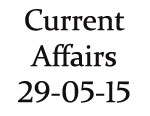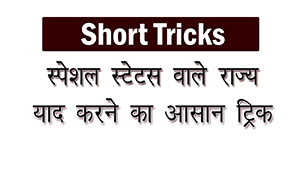-
Current Affairs 28th May 2015
Updated : 29-May-2015
Current Affairs 28th May 2015 - Important Points
Which state of India withdrew AFSPA - Tripura
Union Sports Ministry gave nod for creation of - Indigenous sports disciplines as Regional Sports Federations (RSF's)
Union Ministry of Corporate Affairs notified which law - Companies (Amendment) Act, 2014
Which program was organised in Himachal Pradesh for saving girl child - Ajanmi Beti Ke liye Daud
Up to what percent RBI notified FIIs to invest in Gammon Infrastructure Projects Limited - 49 percent
Who has been resigned as Managing Director of Procter and Gamble India - Shantanu Khosla
State of Food Insecurity in the World 2015 report
Current Affairs 28th May 2015 - Details
Which state of India withdrew AFSPA - Tripura
Among the Important National Current Affairs, On 27th May 2015, State government of Tripura withdrew the Armed Forces Special Powers Act (AFSPA) from the remaining areas of the state with immediate effect.
In the meeting which was chaired by Chief Minister Manik Sarkar this decision was taken after the Tripura police in its latest half-yearly review found no need to extend the Act further. Now this will be forwarded to the Home Ministry so that it can be implemented formally.
Do You Know :
Armed Forces Special Powers Act (AFSPA) was enforced in Tripura on 16th February 1997. It was enforced in 40 police station areas of the state which were dominated by tribal due to relentless violence and bloodshed.
Union Sports Ministry gave nod for creation of - Indigenous sports disciplines as Regional Sports Federations (RSF's)
Among the Sports Current Affairs, On 27th May 2015, Union Ministry of Youth Affairs and Sports gave its nod for recognising certain sports federations representing indigenous sports disciplines as Regional Sports Federations (RSF) so that regional sports can also be promoted. Following are the conditions for a sport to get status of RSF :
1. It should be popular in a region or a state and played in one or more states.
2. It should have been played in the region for at least last 10 years.
3. Sports federations which are seeking RSF status should have conducted championships in all the categories namely Senior, Junior and Sub-Junior.
4. If there is some International body related to that sport then recognition of the said body would be necessary.
5. Only one RSF will be there for one sport.
6. Federations of only indigenous sports will be considered for recognition as RSFs and for remaining sports disciplines, the present guidelines for grant of recognition to NSFs will continue.
Union Ministry of Corporate Affairs notified which law - Companies (Amendment) Act, 2014
On 27th May 2015, Union Ministry of Corporate Affairs notified the Companies (Amendment) Act, 2014. This was notified in the Official Gazette. In early May 2015 President of India gave his assent to the act. In total sixteen amendments were done in the bill which inclues winding up of companies, board resolutions, bail provisions and utilisation of unclaimed dividends etc. Companies Act, 2013 was ammended for it.
Following are few Important Points about these ammendments :
- It seeks to simplifying bail provisions. For instance, except in various issues of serious frauds, normal Criminal Procedure Code (CrPC) provisions would apply.
- To maintain the confidentiality of the board resolutions, the relevant amendment now prohibits public inspection of board resolutions filed in the registry.
- The paid-up capital criteria have been scrapped while threshold limits for various transactions for getting shareholders nod has now been stipulated.
- Specific punishment for deposits accepted, a condition that was left out in the Companies Act, 2013 inadvertently.
- Corporate are exempted from the need to get shareholders’ nod in the case of related party transactions valued lower than 100 crore rupees or 10 percent of net worth. Earlier corporate were required to get shareholders permission for party transactions valued more than 10 crore rupees.
- Transactions between holding companies and wholly owned subsidiaries are exempted from the requirement of approval of non-related shareholders.
Which program was organised in Himachal Pradesh for saving girl child - Ajanmi Beti Ke liye Daud
On 27th May 2015, A marathon was organised by Forum for Human Rights and Justice (FHRJ) in Shimla, Himachal Pradesh. This marathon was named as Ajanmi Beti Ke liye Daud (Protecting the Unborn Girl) with an objective to save girl child and fix the declining sex ratio in the state.
Himachal which is a state of temples is among the ten worst states wherein sex ratio is worst. Current child sex ratio is 906 against 1000. Una has lowest 875, while Kangra (876), Hamirpur (887), Solan (899) and Bilaspur (900) are the other districts which have worst sex ratio.
Up to what percent RBI notified FIIs to invest in Gammon Infrastructure Projects Limited - 49 percent
Among the Important Banking Current Affairs, On 27th May 2015, Reserve Bank of India (RBI) notified that Foreign Institutional Investors (FIIs) or the Registered Foreign Portfolios Investors (RFPIs) can invest up to 49 percent of the paid up capital in the Gammon Infrastructure Projects Limited under the Portfolio Investment Scheme (PIS).
These purchases can be made through primary market and through stock exchange however these purchases are subjected to Regulation 5(2) of FEMA Notification dated 3 May 2000 and other terms and conditions stipulated by the Reserve Bank.
Do You Know :
This change was notified by RBU under FEMA Act, 1999.
Who has been resigned as Managing Director of Procter and Gamble India - Shantanu Khosla
On 27th May 2015, Shantanu Khosla resigned as the Managing Director (MD) of Procter and Gamble (P&G), India. His last working day will be 30th June 2015. He joined Procter and Gamble (P&G), India in 1983.
Al Rajwani has been appointed as new Managing Director & CEO of the company. Rajwani has more than 34 years experience working for P&G in countries including US, Canada, China, Korea and Arabian Peninsula.
State of Food Insecurity in the World 2015 report
Among the Important reports, On 27th May 2015, UN hunger report titled State of Food Insecurity in the World 2015 was released by Food and Agriculture Organization of the United Nations (FAO), the International Fund for Agricultural Development (IFAD) and the World Food Programme (WFP).
As per this report the number of hungry people in the world has dropped to 795 million. Earlier in 1990-92 report hungry people in the world were 1011 million. There is a decline in number of hungry people despite population growth. Following are few highlights of the report :
- The prevalence of undernourishment in developing regions, which measures the proportion of people who are unable to consume enough food for an active and healthy life, has declined to 12.9 percent of the population.
- 72 out of 129 countries monitored by FAO have achieved the Millennium Development Goal target of halving the prevalence of undernourishment by 2015, with developing regions as a whole missing the target by a small margin.
- 29 countries have met the more ambitious goal of halving the absolute number of undernourished people by 201, laid out at the World Food Summit in 1996.
- Over the past 30 years, crises have evolved from catastrophic, short-term, acute and highly visible events to protracted situations, due to a combination of factors, especially natural disasters and conflicts, with climate change, financial and price crises frequently among the exacerbating factors.
- Hunger rates in countries enduring protracted crises are more than three times higher than elsewhere. In 2012, some 366 million people were living in this kind situation, out of whom 129 million were undernourished.
- Sub-Saharan Africa is the region with the highest prevalence of undernourishment in the world with 23.2 percent, or almost one in every four people. However, some African nations also achieved their MDG hunger target, notably in West Africa.
- The proportion of hungry people in Latin America and the Caribbean has dropped from 14.7 percent to 5.5 percent since 1990.
- In southern Asia, the prevalence of undernourishment has declined modestly, to 15.7 percent from 23.9 percent, but much greater progress was made in reducing underweight among young children.
- In West Asia, where hygiene conditions are generally advanced and child underweight rates low, the incidence of hunger has risen due to war, civil strife and consequent large migrant and refugee populations in some countries.
As far as India is concerned, then 194.6 million people are still undernourished. India still has the second-highest estimated number of undernourished people in the world.














